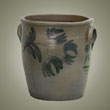In the 1850s, Johnstown, Pennsylvania was a very busy place.
One of its many small industries was the production of salt
glazed stoneware crockery in a wide variety of shapes and sizes.
In the days before canning and other methods of preserving
food developed, these crocks were essential items in every
household for the storage of liquids, butter, cheese, sauerkraut,
and many other foods. Many have survived, and today
collectors appreciate their sturdy, functional forms and charming
hand-painted decoration.
Early potteries were established by Hamilton and Pershing,
and A. J. Haws, but the most well-known was that of Jacob
Swank and Co. In the early years, most pottery was made from
locally sourced clay and thrown on a potter's wheel. Larger
crocks and serving pieces were generally decorated using cobalt
oxide, which produces the striking blue designs seen on this type
of pottery. For strength, the clay pieces had to be fired at
temperatures in excess of 2200 degrees Fahrenheit. After the
kiln was fired for 24 to 48 hours, salt was introduced into the hot
chamber through small holes in the kiln wall. The heated
sodium vapors reacted with silica in the clay, producing a
unique, rough "orange peel" texture on the surface of the clay.
Jacob Swank, his brother Hiram, and Hiram's sons continued to
produce pottery under a variety of company names. As crockery
became less necessary for food storage, they began to produce
firebricks, nozzles, and other items for local refractories such as
the Cambria Iron Works, eventually expanding to state and
national distribution.
Although the Johnstown Flood of 1889 destroyed the pottery
and killed Jacob Swank, surviving family members rebuilt the
pottery and continued production for many more years.
Examples of 19th century pottery produced in Johnstown can be
seen by visiting the Johnstown Area Heritage Association.
Back to Top


